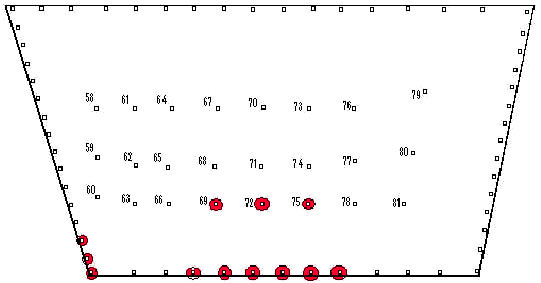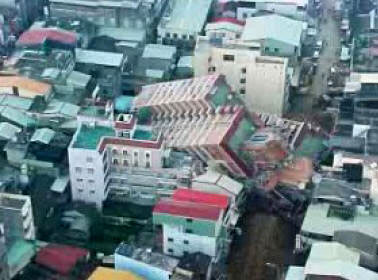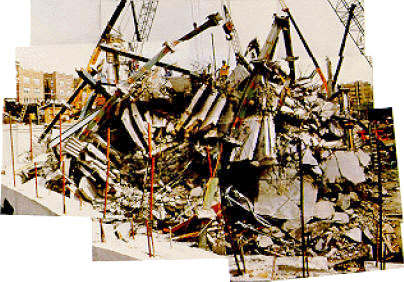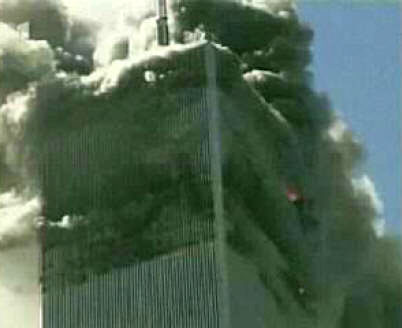|
2. Observed Temperatures around 1000°C and Sulfidation in WTC 7
Steel
One of the relatively few previous peer-reviewed papers
relating to the WTC collapses provides “An Initial Microstructural
Analysis of A36 Steel from WTC Building 7.”
This brief but important
letter states:
While the exact location of this beam could not be determined, the
unexpected erosion
of the steel found in this beam warranted a study of microstructural
changes that
occurred in this steel. Examination of other sections in this beam
is underway.
ANALYSIS
Rapid deterioration of the steel was a result of heating
with oxidation
in combination with intergranular melting due to the presence of
sulfur.
The
formation of the eutectic mixture of iron oxide and iron sulfide
lowers the temperature at
which liquid can form in this steel. This strongly suggests that the
temperatures in this
region of the steel beam approached ~1000°C by a process similar to
making a
“blacksmith’s weld” in a hand forge.
(Barnett, 2001)
How were these ~1000°C temperatures in the steel beam achieved? As
noted above in the quotation from Eagar, it is difficult to reach
temperatures above 650°C in the type of diffuse fires evident in the
WTC buildings, let alone in the steel columns where heat is
transported away by the enormous heat sink of the steel structure.
So the high temperatures deduced by Barnett, Biederman and
Sisson
are indeed remarkable.
Then there is the rather mysterious sulfidation of the steel
reported in this paper—What is the origin of this sulfur? No solid
answer is given in any of the official reports.
Of course, there is a straightforward way to achieve 1000°C
temperatures (and well above) in the presence of sulfur, and that is
to use thermate (or a similar variation of thermite).
Thermate is a
high-level thermite analog containing sulfur
developed by the
military. Thermate combines aluminum/iron oxide (thermite) with barium
nitrate (29%) and sulfur (typically 2% although more sulfur could be
added).
The thermate reaction proceeds rapidly and is much faster
than thermite in degrading steel leading to structural failure.
Thus, both the unusually high temperatures and the extraordinary
observation of steel-sulfidation (Barnett, 2001) can be accounted
for—if the use of thermate is allowed in the discussion. Note that
other oxidizers (like KMnO4) and metals (like titanium and silicon)
are commonly used in thermite analogs.
Finally, sulfidation was observed in structural steel samples found
from both WTC7 and one of the WTC Towers, as reported in Appendix C
in the FEMA report. It is quite possible that more than one type of
cutter-charge was involved on 9/11, e.g., HMX, RDX and thermate in
some combination. While gypsum in the buildings is a source of
sulfur, it is highly unlikely that this sulfur could find its way
into the structural steel in such a way as to form a eutectic. The
evidence for the use of some variant of thermite such as
sulfur-containing thermate in the destruction of the WTC Towers and
building 7 is sufficiently compelling to warrant serious
investigation.
Back To Contents
3. Near-Symmetrical Collapse of WTC 7
As you observed (link above), WTC 7 collapsed rapidly and
nearly-straight-down
symmetrically—even though fires were randomly scattered in the
building. WTC 7 fell about
seven hours after the Towers collapsed, even though no major
persistent fires were visible
(considerable dark smoke was seen).
There were twenty-four huge
steel support columns inside
WTC 7 as well as huge trusses, arranged non-symmetrically, along
with some fifty-seven
perimeter columns, as indicated in the diagram below (FEMA, 2002,
chapter 5; NIST, 2005).

Diagram showing steel-column arrangement in WTC 7, view looking down
on the roof.
Circled columns in red were possibly damaged due to debris from WTC 1
collapse, some 350 feet
away (NIST, 2005) so the damage was clearly non-symmetrical, and
evidently, none of the core
columns was severed by falling debris. WTC 7 was never hit by a
plane.
A near-symmetrical collapse, as observed, evidently requires the
simultaneous “pulling” of many of the support columns (see below,
particularly discussion of Bazant & Zhou paper). The likelihood of
complete and nearly-symmetrical collapse due to random fires as in
the “official” theory is small, since non-symmetrical failure is so
much more likely.
If one or a few columns had failed, one might
expect a portion of the building to crumble while leaving much of
the building standing. For example, major portions of WTC 5 remained
standing on 9/11 despite very significant impact damage and severe
fires.


Non-symmetrical collapse of tall buildings when due to random
causes. L’Ambiance Plaza
collapse (far above) shows how pancaked concrete floor slabs are largely
intact and clearly reveal
stacking effects with minimal fine dust, as expected from random
progressive collapse. By
contrast, concrete floors in the Twin Towers and WTC 7 were
pulverized to dust—as is common in controlled demolitions using
explosives.
On the other hand, a major goal of
controlled demolition using cutter-charges/explosives is the
complete and straight-down-symmetrical collapse of buildings. The
reader may wish to review controlled-demolition examples
here, for examples of complete
symmetrical collapses due to carefully pre-positioned explosives.
(The videos of the Philips Building, Southwark Towers, and
Schuylkill Falls Tower collapses are particularly instructive.)
Concluding remarks in the FEMA report on the WTC 7 collapse lend
support to these arguments:
The specifics of the fires in WTC 7 and how they caused the building
to collapse [“official theory"] remain unknown at this time.
Although the total diesel fuel on the premises contained massive
potential energy, the best hypothesis [fire/debris-damage caused
collapse] has only a low probability of occurrence. Further
research, investigation, and analyses are needed to resolve this
issue.
(FEMA, 2002, chapter 5; emphasis added.)
That is precisely the point: further investigation and analyses are
indeed needed, including serious consideration of the
controlled-demolition hypothesis which is neglected in all of the
government reports (FEMA, NIST and 9-11 Commission reports).
Note
that the 9-11 Commission report does not even mention the collapse
of WTC 7 on 9-11-01. (Commission, 2004) This is a striking omission
of data highly relevant to the question of what really happened on
9-11.
Back To Contents
4. No Previous Skyscraper Complete Collapse Due to Fires
A New York Times article entitled “Engineers are baffled over the
collapse of 7 WTC;
Steel members have been partly evaporated,” provides relevant data.
Experts said no building like it [WTC7], a modern, steel-reinforced
high-rise, had ever collapsed because of an uncontrolled fire.
(Glanz, 2001; emphasis added.)
Fire engineering expert Norman Glover agrees:
-
Almost all large buildings will be the location for a major fire in
their useful life.
-
No major high-rise building has ever collapsed from fire…
-
The WTC [itself] was the location for such a fire in 1975; however,
the building survived with minor damage and was repaired and
returned to service.”
(Glover, 2002)
That’s correct – no steel-beam high-rise had ever before (or since)
completely collapsed due to fires! However, such complete and nearly
symmetrical collapses in tall steel-frame buildings have occurred
many times before—all of them due to pre-positioned explosives in a
procedure called “implosion” or controlled demolition. What a
surprise, then, for such an occurrence in downtown Manhattan— three
skyscrapers completely collapsed on the same day, September 11,
2001, presumably without the use of explosives.
Engineers have been trying to figure out exactly what happened and
whether they should be worried about other buildings like it around
the country… Most of the other buildings in the [area] stood despite
suffering damage of all kinds, including fire...
‘Fire and the
structural damage …would not explain steel members in the debris
pile that appear to have been partly evaporated’, Dr. [Jonathan]
Barnett said.
(Glanz, 2001; emphasis added.)
The observed “partly evaporated” steel members is particularly
upsetting to the official theory, since fires involving paper,
office materials, even diesel fuel, cannot generate temperatures
anywhere near the ~5,180 oF (~2860 oC) needed to evaporate steel.
(Recall that WTC 7 was not hit by a jet, so there was no jet fuel
involved in the fires in this building.)
However, thermite-variants,
RDX and other commonly-used incendiaries or explosives (i.e.,
cutter-charges) can readily slice through steel, thus cutting the
support columns in a controlled demolition, and reach the required
temperatures. This mystery needs to be explored – but is not
mentioned in the “official" 9-11 Commission or NIST reports.
Back To Contents
5. Squib-timing during the Collapse of WTC 7
Horizontal puffs of smoke and debris are observed emerging from
WTC-7 on upper floors, in regular sequence, just as the building
starts to collapse. (The reader may wish to view the close-up video
clip again.) The upper floors have evidently not moved relative to
one another yet, from what one can observe from the videos. In
addition, the timing between the puffs is less than 0.2 seconds so
air-expulsion due to collapsing floors (see Chertoff, 2005) is
evidently excluded.
Free-fall time for a floor to fall down to the
next floor is significantly longer than 0.2 seconds: the equation
for free fall, y = ½ gt2, yields a little over 0.6 seconds, as this
is near the initiation of the collapse.
However, the presence of such “squibs” proceeding up the side of the
building is common when pre-positioned explosives are used, as can
be
observed here. The same
site shows that rapid timing between explosive squibs is also
common. (It is instructive to view several of the implosion videos
at this web site.) Thus, squibs as observed during the collapse of
WTC 7 going up the side of the building in rapid sequence provide
additional significant evidence for the use of pre-placed
explosives.
Release by the government (NIST, in particular) of all
videographic and photographic data showing details of the fires,
damage, and collapse of WTC 7 on 9/11/2001would allow us to analyze
these squib data in greater detail, to determine whether breaking
windows or explosive charges are evidenced in the observed puffs of
smoke. Horizontal plumes and sounds of explosions are even more
pronounced in available videos of the collapses of the WTC Towers
(see sections 7 and 8 below).
Regarding this highly-secure building, a NY Times article entitled
“Secretive C.I.A.
Site in New York was Destroyed on Sept. 11,” provides an intriguing
puzzle piece:
“The C.I.A.’s undercover New York station was in the 47-story
building at 7 World Trade Center… All of the agency’s employees at
the site were safely evacuated… The intelligence agency’s employees
were able to watch from their office windows while the twin towers
burned just before they evacuated their own building.”
(Risen, 2001)
Back To Contents
6. Early Drop of North Tower Antenna
The official FEMA 9-11 report admits a striking anomaly regarding
the North Tower collapse:
Review of videotape recordings of the collapse taken from various
angles indicates that the transmission tower on top of the structure
began to move downward and laterally slightly before movement was
evident at the exterior wall. This suggests that collapse began with
one or more failures in the central core area of the building.
(FEMA, 2002, chapter 2; emphasis added.)

North Tower showing antenna (top) at beginning of collapse.
Yes, we can see for ourselves that the antenna drops first from
videos of the North Tower collapse.
See,
A NY Times
article also notes this behavior:
The building stood for more than an hour and a half. Videos of the
north tower’s collapse appear to show that its television antenna
began to drop a fraction of a second before the rest of the
building. The observations suggest that the building’s steel core
somehow gave way first…
(Glanz and Lipton, 2002; emphasis added)
But how? What caused the 47 enormous steel core columns of this
building which supported the antenna to evidently give way nearly
simultaneously, if not cutter charges?
The anomalous early antenna-drop was noted by the FEMA report (FEMA,
2002) and the New York Times (Glanz and Lipton, 2002) yet not
resolved in the official reports
(FEMA, 2002;
Commission, 2004; NIST, 2005).
The NIST report notes that:
...photographic and videographic records taken from due north of the
WTC 1 collapse appeared to indicate that the antenna was sinking into the roof
{McAllister 2002}. When records from east and west vantage points
were viewed, it was apparent that the building section above the
impact area tilted to the south as the building collapsed.
(NIST,
2005)
However, we find no quantitative analysis in the report which shows
that this tilting of the
building section was sufficient to account for the large apparent
drop of the antenna as seen from
the north, or that this building-section-tilting occurred before the
apparent antenna drop. Furthermore, the FEMA investigators also
reviewed “videotape recordings of the collapse taken from various
angles” yet came to the sense that,
“collapse began with one or more
failures in the central core area of the building.”
(FEMA, 2002)
Quantitative analysis needs to be done and shown to resolve the
issue.
Gordon Ross has written a scholarly paper on the collapse of WTC 1,
which carefully considers conservation of momentum and conservation
of energy,
here. He shows that
even if the Tower started to collapse due to fire and damage, it
would not continue to complete collapse.
Note that the collapse of
the McCormick Place building in Chicago is an example of a partial
collapse only of a steel-frame building due to fire. The roof
collapsed, but since the walls of that one-story building remained
standing, it is clearly not comparable to the complete collapses of
three WTC skyscrapers on 9/11/2000.
Back To Contents
7. Eyewitness Accounts of Flashes and Loud Explosions
Multiple loud explosions in rapid sequence were heard and reported
by numerous
observers in and near the WTC Towers, consistent with explosive
demolition. Firemen and
others described flashes and explosions in upper floors near where
the plane entered, and in
lower floors of WTC 2 just prior to its collapse, far below the
region where the plane had struck
the tower (Dwyer, 2005).
For instance, at the start of the collapse
of the South Tower a Fox
News anchor reported:
There is an explosion at the base of the building… white smoke from
the bottom… something happened at the base of the building! Then
another explosion.”
(De Grand Pre, 2002, emphasis added.)
Firefighter Edward Cachia independently reported:
[We] thought there was like an internal detonation, explosives,
because it went in succession, boom, boom, boom, boom, and then the
tower came down…It actually gave at a lower floor, not the floor
where the plane hit.
(Dwyer, 2005; emphasis added.)
And Assistant Fire Commissioner Stephen Gregory provides additional
insights:
When I looked in the direction of the Trade Center before it came
down, before No. 2 came down, ..I saw low-level flashes. In my
conversation with Lieutenant Evangelista, never mentioning this to
him, he questioned me and asked me if I saw low-level flashes in
front of the building, and I agreed with him because I thought—at
that time I didn’t know what it was. I mean, it could have been as a
result of the building collapsing, things exploding, but I saw a
flash flash flash and then it looked like the building came down.
Q. Was that on the lower level of the building or up where the fire
was?
A. No, the lower level of the building. You know like when they
demolish a building, how when they blow up a building, when it falls
down? That’s what I thought I saw. And I didn’t broach the topic to
him, but he asked me. He said I don’t know if I’m crazy, but I just
wanted to ask you because you were standing right next to me… He
said did you see any flashes? I said, yes, well, I thought it was
just me.
He said no, I saw them, too... I mean, I equate it to the building
coming down and
pushing things around, it could have been electrical explosions, it
could have been
whatever.”
(Dwyer, 2005, Assistant Commissioner Stephen Gregory FDNY
WCT2 File
No. 91 10008; emphasis added.)
It is highly unlikely that jet fuel was present to generate such
explosions especially on lower floors, and long after the planes hit
the buildings. Dr. Shyam Sunder, Lead Investigator for NIST stated:
“The jet fuel probably burned out in less than 10 minutes.”
(Field,
2005)
“Electrical explosions” would clearly be insufficient to bring
a steel-frame skyscraper down, in any building built to code.
On the
other hand, pre-positioned explosives provide a plausible and simple
explanation for the observed detonations followed by complete
building collapses. Thus, it cannot be said that “no evidence” can
be found for the use of explosives. This serious matter needs to be
treated as a plausible scientific hypothesis and thoroughly
investigated.
“118 Witnesses: The Firefighters’ Testimony to Explosions in the Twin Towers” by
Graeme MacQueen provides
significant details regarding eyewitness accounts.
Back To Contents
8. Ejection of Steel Beams and Debris-plumes from the
Towers
The horizontal ejection of structural steel members for hundreds of
feet and the pulverization of concrete to flour-like powder,
observed clearly in the collapses of the WTC towers, provide further
evidence for the use of explosives – as well-explained in
http://911research.wtc7.net/talks/towers/index.html (See also,
Griffin, 2004, chapter 2.)
The observed plumes or “squibs” are far
below the pulverization region and therefore deserving of particular
attention. They appear much like the plumes observed in
http://www.implosionworld.com/cinema.htm (e.g., the controlled
demolition of the Southwark Towers).

North Tower during top-down collapse.
Notice mysterious horizontal plumes far below pulverization region.
Unlike WTC7, the twin towers appear to have been exploded “top-down”
rather than proceeding from the bottom – which is unusual for
controlled demolition but clearly possible, depending on the order
in which explosives are detonated.
That is, explosives may have been
placed on higher floors of the towers and exploded via radio signals
so as to have early explosions near the region where the plane
entered the tower. Certainly this hypothesis ought to be seriously
considered in an independent investigation using all available data.
Back To Contents
|




